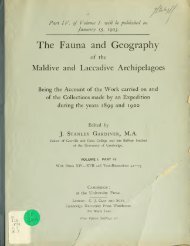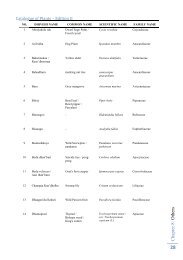Download - WordPress – www.wordpress.com
Download - WordPress – www.wordpress.com
Download - WordPress – www.wordpress.com
You also want an ePaper? Increase the reach of your titles
YUMPU automatically turns print PDFs into web optimized ePapers that Google loves.
636 R. C. PUNNETT.Internal structube.Proboscis. The outer circular muscle layer is very delicate. The proboscis contains acentral cavity which is not divided into right and left portions in fi-ont of the central<strong>com</strong>plex. The long vermiform process of the stomochord runs forwards dorsal to the cavity(PL XLI. fig. 8, v.). It is somewhat fragmented in places. Where it joins the stomochordj)roper appears the ventral septum separating the ventral coelom into two portions, whichdo not subsequently join with one another. A dorsal septum also occurs in front of thejunction of the pericardium with the basement membrane below the epidermis. The lumenof the stomochord is well marked in some places though obliterated in others. The lumenof the lateral diverticula is only patent at the extremity of each. The chondroid tissue iswell developed. The nuchal skeleton possesses a well-marked keel.The left proboscis pore alone is present. The right perihaemal cavity reaches forwardsconsiderably further than that of the left side (PI. XLI. fig. 6, ph.).The pericardial auricles are very short.Collar. The outer longitudinal muscles are jjoorly developed and there is no circularlayer. The collar is without a cavity. The dorsal septum extends through the length ofthe collar, whilst the ventral one is only found <strong>com</strong>plete at the posterior end.The nerve cord is practically solid throughout, only very faint traces of a lumen beingdiscoverable here and there. There is no sign of any dorsal root.The cornua of the nuchal skeleton are long and reach backwards to the extreme hindend of the collar (PI. XLI. fig. 8, en.) and to some extent overlap the branchial region.The collar pores open into the first gill pouch, which possesses a small diverticulumreaching forwards for a short distance ventral to the collar canal (PI. XL. fig. 8, p. 1). Thisis doubtless the structure referred to by Willey ('99, p. 280) as the truncal canal. Inthe present species it possesses no trace of an opening into the perihaemal space, and thediverticulum differs in nowise histologically from the rest of the gill pouch, thus lendingno support to the morphological importance with which Willey is inclined to regard them.Trunk. The circular musculature is, as usual in this genus, found inside the longitudinallayer. In the branchial region the ventral portion of the oesophagus is almost as large asthe branchial division, the proportions being similar to those in Sp. porosa as figured byWilley ('99, PL XXXI. fig. 45). About nine synapticula are present on each gill bar. Adistinct but small post-branchial groove is present (PL XLII. fig. 20). The grooves intowhich the gill pouches open are produced backwards past the branchial region. They donot however exhibit the peculiar depressions found in Sp. porosa and Sp. alba which Willeyhas termed dermal pits. Too much stress must not be laid on their absence, however, asthe gonads are somewhat immature and it is possible that with their increase in size smalldermal pits might arise. There is little doubt that they would never reach the samedevelopment as in the above-named forms, a circumstance jirobably correlated with the smallersize of the species under consideration.In the branchial region both median and lateral gonads are present. In the genitalregion however the lateral gonads alone are present. The median gonads are always verysmall and are not nearly so numerous as the lateral ones.Though the above species has been created on the strength of a single imperfectspecimen yet in its short collar, its undivided proboscis cavity, the reduction or absence of






